Every Thursday and Sunday evening the world meets at the beaches of Darwin, Australia, in the famed Mindil Market. Continue reading
Category Archives: Australia
Raging Out in Sidney Which Got Wild And Weird for Vivid (not the Porn Company)
For two and a half weeks in late spring every year, Sydney takes over the mantle of City of Light (sorry, Paris). The city-wide Vivid Light festival transforms Sydney “into a wonderland of ‘light art’ sculptures, innovative light installations, and grand-scale projections for all to enjoy — for free,” promises the website. “It is a magical celebration of light-design excellence and the world’s largest outdoor ‘art-gallery’: a unique Vivid Sydney experience.”
And it is wild. The facades of public buildings appear to come alive — taken over by (video) vines and (projections of) the ocean. Forests of fluorescent trees sprout up by the waterfront and musical steps that rival that famous scene in the movie Big are everywhere.
It is magical, transformative, and fun. If you’ve ever wanted to go to Australia, book your ticket for the end of May so you can check out Vivid. It is worth every free penny.
The Stolen Generation: Australia’s Dark and Tragic Past
Imagine this: You have a child playing in your front yard. As you watch through the window, a van of policemen pulls up. They walk past your front gate and take your screaming child away. You never see your child again.
And it’s all legal.

This man never knew his real family.

Aboriginal pupils in the junior class of St. Joseph’s Catholic Mission school at Hammond Island. (Photo: Alan Lambert/The AGE/Fairfax Media via Getty Images)
This is what happened to Deanne Kenyon’s grandfather and countless other Aboriginals in Australia from 1906 up until the 1970s — all because of the color of their skin. Children who were very dark were allowed to stay with their parents, causing many indigenous people to dye their children’s skin dark using the sap of the milkwood tree. But if a child looked as if he had any white ancestry, he was taken away. Some, if they were white enough, were adopted by white families, but the majority were sent to harsh missionary schools, where they were purged of their history, past, and memories and taught how to “fit in” to white Australian society.

Aboriginal Elder Nancy Hill-Wood from Sydney holds a protest banner in front of Old Parliament House on February 11, 2008 in Canberra, Australia. Aborigines arrive in Canberra for apology to the stolen generations. (Photo: Andrew Sheargold/Getty Images)
How to Swim With Crocodiles
Because, boys and girls, this could actually come in handy. I swear. for full croc awesomeness:
Inside the Cage of Death: Swimming With Australia’s Monster Crocs
Ever since I was a child, I’ve had both an obsessive fascination and fear of saltwater crocodiles. They are one of the only creatures alive today that have been around since the prehistoric time of the dinosaurs — in fact, they are considered by some to be living dinosaurs. Since coming back from the brink of extinction in the mid-20th century, anyone venturing into the Australia’s northern territory can see one … just look on the river banks — or the beaches (crocodiles have been known to surf the waves around Darwin, not kidding). But considering they are expert stealth predator, and several people die every year from croc attacks, how close can you get? Pretty close, it turns out.
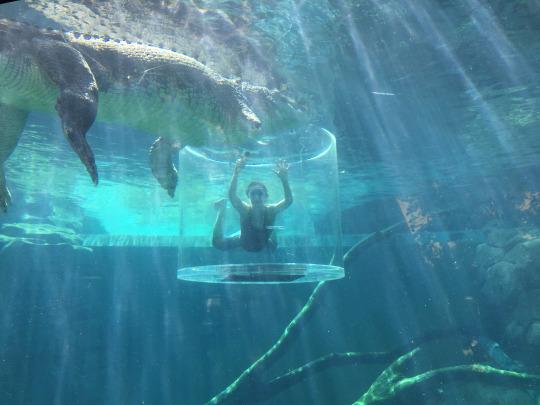
Yes, you can get this close. And yes, it is terrifying.
But before I hit something called the Cage of Death, I’m going to ease into it. Outside of Darwin, on the banks of the Adelaide River, are the Jumping Croc Cruises, where for $30 dollars you can hop on a flat-bottomed boat with roughly 20 other tourists (no dogs allowed, for obvious reasons) and cruise down the muddy river looking for crocodiles, preferably at feeding times (late morning or evening).
Related: Everything in Australia Wants to Kill You
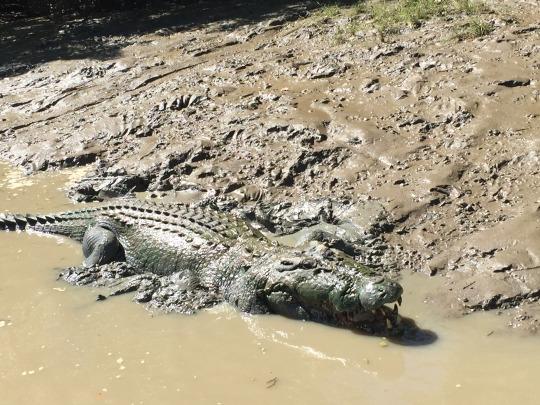
This guy was about 20 feet long … and very hungry.
Boat staff on the boat lure crocs from the riverbanks by attaching red meat to fishing lines and tapping the water with it.
“They feel the vibration in the water and come,” said our baiter, Kyla. “We like to make them jump so they work for their food and burn some calories. The exertion it takes for them to jump cancels out the calories from the meat, so they do still have to hunt in the wild.”
Related: G’Day Mate! How to Speak Australian
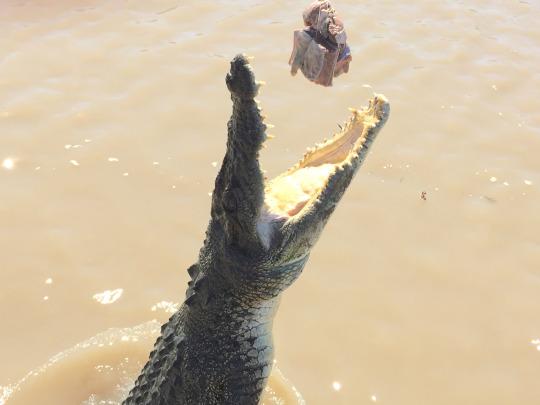
Crocs on the cruise jump as high as five feet for meat — and have been known to jump even higher.
Everything in Australia Wants to Kill You
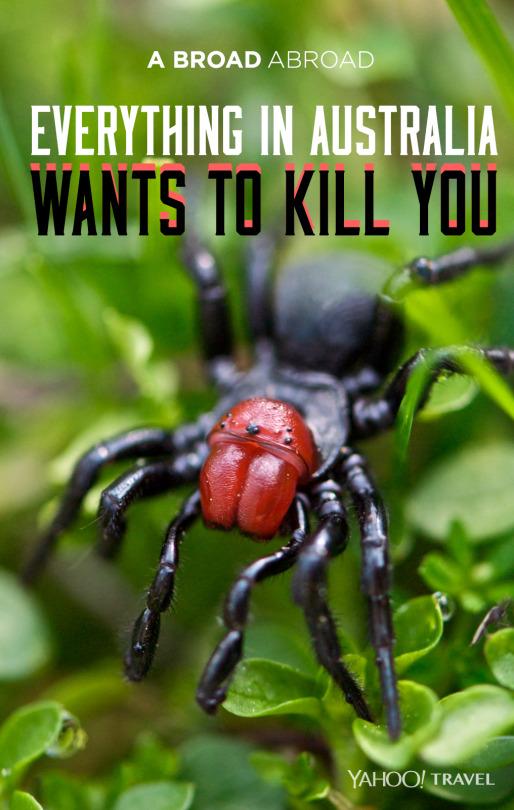
Photo by 167/Brooke Whatnall/Ocean/Corbis. Design by Erik Mace for Yahoo Travel.
It’s a weird, fun fact that as beautiful as it is, everything in Australia wants to kill you. Or at least hurt you real bad. Take, for example, spinifex, the tall grass that grows throughout the desert plains. From far away it looks soft and supple – swaying in the wind.
But this is no Andrew Wyeth bed of grass: spinifex has spikes, thorns, and when it’s dried out it is so strong it can pierce most flip-flops. At least you will (presumably) survive spinifex barbs in your foot. Which is more than I can say for pretty much everything else in Australia.
Related: Experience Uluru, Australia’s Most Awe Inspiring Natural Wonder (Without the 24 Hr flight)

Paula, risking it all in Australia. (Photo: A Broad Abroad)
There are too many to list. Camels in heat will bite your head off? YES THEY WILL! Kangaroos may try to eviscerate you with one back claw judo swipe? HECK, YES THEY WILL! That cute fluffy looking bird will try to peck your eyes out? YOU BET IT WILL!
So I decided to keep it simple and compiled the top 10 things that will kill you — just in case you happen to head to the land down under and need to know the worst things to look out for.
But you may want to travel in a bubble suit, just in case.
Related: G’Day, Mate! How to Speak Australian
How To Feed Your Crocodile
Because you just never know when this info will come in handy… for full croc awesomeness:
Check Out A Deadly 350 Million Yr Old Salt Lake in Australia’s Outback
The Australian Outback is a lot like the American West — vast, beautiful, and lonely. Animals outnumber the people about 500 to one (depending on your source), and everywhere you look are canyons, deserts, and flat. Lots of flat … and a never-ending sky. But Australia’s outback is about 10 times larger than the American West — and millions of years older.
Once, around 350 million years ago, much of the Australian Outback was covered by a huge inland sea. Today, nothing is left of that ocean except huge salt flats that dot the landscape around Uluru (formerly known as Ayers Rock), Kata Tjuta, and Mount Conner — the three most recognizable features in the Outback.
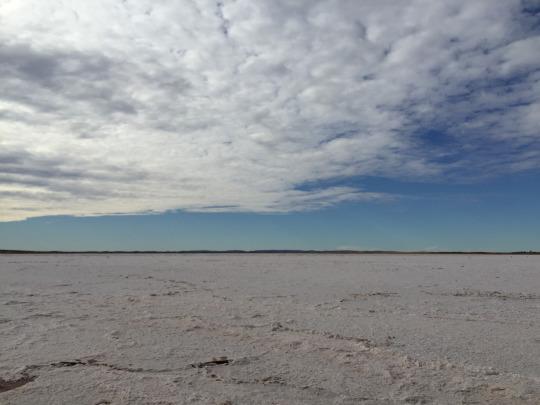
The wide-open landscape of the Australian Outback. (Photo: Paula Froelich)
Unlike Uluru or Kata Tjuta, Mount Conner, while still considered sacred by the local Aboriginal people, lies in the middle of a million-acre cattle farm owned by the Severin family. (The land was privatized in 1938, and all Aboriginals were moved off. But because Mount Conner isn’t as sacred as the other sites in the area, no one has come to claim it, so the land remains in private hands.) Located off the Peterman highway, a one-lane dirt road, many people call it “Fool-uru” because of its similarities to Uluru and its history.
“Back in the day, people would come from Alice Springs on the Peterman Highway — it was the only road out here from Alice Springs for years — and they would see Mount Conner and say, ‘Oh! Uluru!’, and turn around and go back home,” my friend and guide Stacy Beswisk laughed. “Many people never actually saw Uluru.”
These days, only the Severin family members have access to the top of Mount Conner (the youngest son was married there several years ago) but, as with Uluru, the drive around it is spectacular.
Related: G’Day Mate! How To Speak Australian
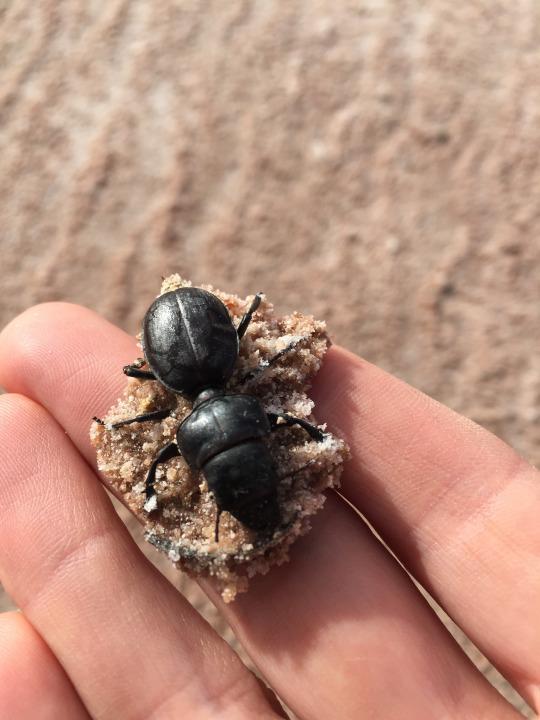
Mummified bug in the salt lake. (Photo: Paula Froelich)
Even more interesting is Lake Swanson, also on the ranch but about 10 miles away from Mount Conner.
Surrounded by salt bush and a few desert oaks, which Beswisk estimates are around 450 years old, the huge salt lake is all that’s left of the inland ocean.
“They used to mine salt here,” Beswisk said. “No more. … Now you can’t take it out of the country.”
Experience Uluru: Australia’s Iconic Spiritual Landmark (Without the 24 Hr Flight!)
Named Ayer’s Rock by colonists, Uluru is a massive sandstone monolith in the heart of the Northern Red Centre desert – in the southern most part of the Northern Territory.
While I’d visited Australia a few times [full disclosure: I almost married an Australian so had to make the trip several times, despite the hellacious 24 hour flight], I’d never made the 1,000 mile, Sydney to Uluru trek. In my defense, I was busy meeting the at the time, soon-to-be-future in-laws that never were. But it has always figured large in my mind and was number one on my Bucket List.
Related: G’Day Mate! How to Speak Australian
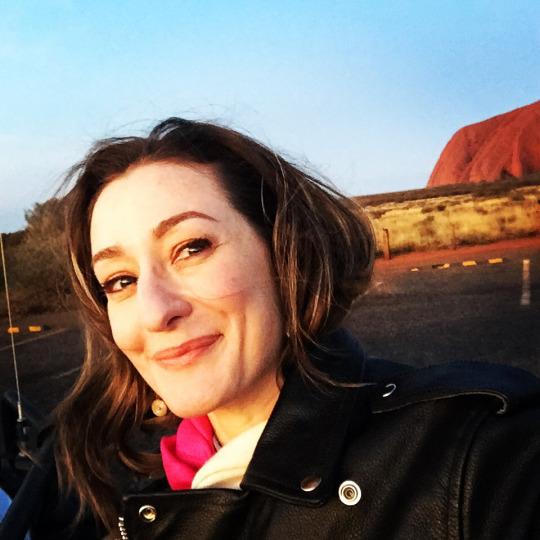
It’s not an Aussie selfie unless Uluru is in there.
So when I got the chance to visit the Outback, my first stop was Uluru.
Rising out of what seems like nowhere, Uluru is sacred to the local indigenous nation – the Anangu – and believed to be about 700 million years old. While it seems massive, rising 1,000 feet high out of the ground, like an iceberg, what you see is just the tip.
“It is a huge solid rock,” my guide Ryan Clark, told me. “It is embedded in the ground. Sometime about 300 million years ago it turned on its side which is why the sandstone (stripes) look like they are going up and down instead of left to right.”
Related: Go Now: The New Seventh Wonder of the World That’s Empty
Dually listed as a World heritage Site for both its cultural and geological significance, Uluru went through a dark period starting in 1958, when the government took it and the surrounding land from the Anangu people and set up an air strip with motels directly next to the rock (on sacred ground). Tourists were allowed to climb Uluru, walking onto land that the Anangu considered holy. But, on October 26th 1985, the government returned the land to the Anangu people – this year is the 30th anniversary of Australia handing back the land to the indigenous owners – and the motels were moved several miles away. Today there are four resorts around Uluru, but at a respectful distance.
G’Day Mate! How to Speak Australian
Australia is an English-speaking country — but, like with England, there are a lot of differences between here and there. So many, in fact, that if you hang with the locals at a pub in the outback, you won’t be totally off base if you sit for a second and wonder, “Just where the hell am I, anyway?”
Related: Lost in Translation: Whose Language Is It Anyway?
Because quite often, Australian English actually needs a translation.
For example, where you might say, “Sharon’s been working very hard, so when we gave her her birthday present she started crying. She needs to toughen up a bit.” — an Australian would translate that to: “Shazza’s been flat out like a lizard drinking. When we gave her a bidet prezzie, the sheila started crying. She needs to drink a cuppa cement.”
Confused? Don’t worry. I’m here to help so that when you take your big trip down under, you’ll fit right in! Watch the video and then, just for fun, translate your thoughts into Australian in the comments below.
